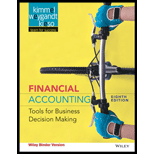
Concept explainers
(a)
Inventory turnover ratio: This is a financial measure that is used to evaluate as to how many times a company sells or uses its inventory during an accounting period. It is calculated by using the following formula:
Days in inventory: Days in inventory are used to determine number of days a particular company takes to make sales of the inventory available with them.
LIFO Reserve: It is a contra inventory account that shows the difference between the inventory cost under FIFO and inventory cost under LIFO. This account is recorded when a company uses FIFO method for its
To Compute: The inventory turnover and days in inventory of Company G.
(b)
To Compute: The
(c)
To Compute: The current ratio after adjusting the LIFO reserve.
(d)
To Comment: on the difference between the current ratio based on inventory using LIFO and the current ratio after adjusting for the LIFO reserve.
Want to see the full answer?
Check out a sample textbook solution
Chapter 6 Solutions
Financial Accounting 8th Edition
- Can you explain the process for solving this financial accounting question accurately?arrow_forwardI need help finding the accurate solution to this general accounting problem with valid methods.arrow_forwardI need help solving this general accounting question with the proper methodology.arrow_forward
- I need help with this general accounting problem using proper accounting guidelines.arrow_forwardI need help with this general accounting question using the proper accounting approach.arrow_forwardGreen, an individual taxpayer who is not a day trader, has requested assistance from a CPA to calculate Year 2 gains and/or losses on the sale of various shares of stock. For each of the following transactions, calculate the correct gain or loss and enter the amount in the associated box in the Gain or Loss column. 4. Sold 1,225 shares of ABC Corp. stock at $9 per share. Green purchased 600 shares several years ago at $30 per share. Three years ago, when the stock price was $21, there was a 2-for-1 stock split, and two years ago, when the stock price was $25, there was a 3-for-2 stock split. No other shares were sold by Green before Year 2. 5. Sold 500 shares of XYZ Corp. stock at $20 per share. Green purchased these shares two years prior at $22 per share. Three weeks prior to the sale, Green purchased 100 shares of XYZ stock at $18 per share. 6. Sold 1,600 shares of BX Corp. stock at $4 per share. Green received these shares as a gift from his sister four years ago. The fair market…arrow_forward
 College Accounting (Book Only): A Career ApproachAccountingISBN:9781337280570Author:Scott, Cathy J.Publisher:South-Western College PubPrinciples of Accounting Volume 1AccountingISBN:9781947172685Author:OpenStaxPublisher:OpenStax College
College Accounting (Book Only): A Career ApproachAccountingISBN:9781337280570Author:Scott, Cathy J.Publisher:South-Western College PubPrinciples of Accounting Volume 1AccountingISBN:9781947172685Author:OpenStaxPublisher:OpenStax College College Accounting, Chapters 1-27AccountingISBN:9781337794756Author:HEINTZ, James A.Publisher:Cengage Learning,
College Accounting, Chapters 1-27AccountingISBN:9781337794756Author:HEINTZ, James A.Publisher:Cengage Learning, Managerial AccountingAccountingISBN:9781337912020Author:Carl Warren, Ph.d. Cma William B. TaylerPublisher:South-Western College Pub
Managerial AccountingAccountingISBN:9781337912020Author:Carl Warren, Ph.d. Cma William B. TaylerPublisher:South-Western College Pub Financial AccountingAccountingISBN:9781305088436Author:Carl Warren, Jim Reeve, Jonathan DuchacPublisher:Cengage Learning
Financial AccountingAccountingISBN:9781305088436Author:Carl Warren, Jim Reeve, Jonathan DuchacPublisher:Cengage Learning Managerial Accounting: The Cornerstone of Busines...AccountingISBN:9781337115773Author:Maryanne M. Mowen, Don R. Hansen, Dan L. HeitgerPublisher:Cengage Learning
Managerial Accounting: The Cornerstone of Busines...AccountingISBN:9781337115773Author:Maryanne M. Mowen, Don R. Hansen, Dan L. HeitgerPublisher:Cengage Learning





